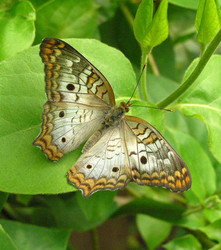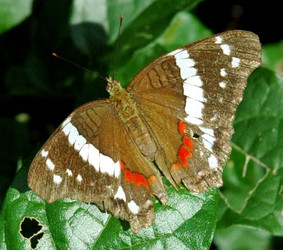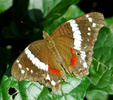Anartia
Andrew V. Z. Brower


This tree diagram shows the relationships between several groups of organisms.
The root of the current tree connects the organisms featured in this tree to their containing group and the rest of the Tree of Life. The basal branching point in the tree represents the ancestor of the other groups in the tree. This ancestor diversified over time into several descendent subgroups, which are represented as internal nodes and terminal taxa to the right.

You can click on the root to travel down the Tree of Life all the way to the root of all Life, and you can click on the names of descendent subgroups to travel up the Tree of Life all the way to individual species.
For more information on ToL tree formatting, please see Interpreting the Tree or Classification. To learn more about phylogenetic trees, please visit our Phylogenetic Biology pages.
close boxIntroduction
A mainly neotropical genus. Two species, Anartia lytrea and A. chrysopelea, occur in the greater Antilles. A. jatrophae, the white peacock, is widespread from the southern U. S. throughout tropical South America. A. fatima occurs in Mexico and Central America and meets South American A. amathea in Panama, where the two intermingle in a hybrid zone (Dasmahaptra et al. 2003).
Discussion of Phylogenetic Relationships
The topology is derived from the Blum et al. (2003) mtDNA tree.References
Blum MJ, Bermingham E, and Dasmahapatra K. 2003. A molecular phylogeny of the neotropical butterfly genus Anartia (Lepidoptera: Nymphalidae). Molecular Phylogenetics and Evolution 26: 46-55.
Dasmahaptra KK, Blum MJ, Aiello A, Hackwell S, Davies N, Bermingham EP, and Mallet J. 2002. Inferences from a rapidly moving hybrid zone. Evolution 56: 741-753.
Lamas G ed. 2004. Atlas of Neotropical Lepidoptera. Checklist: Part 4A Hesperioidea - Papiionoidea. Gainesville: Scientific Publishers/Association of Tropical Lepidoptera.
Title Illustrations

| Scientific Name | Anartia jatrophae |
|---|---|
| Acknowledgements |
This image is
licensed under the Attribution-NonCommercial-ShareAlike 2.0 Creative Commons License. source: flickr: White Peacock |
| Specimen Condition | Live Specimen |
| Copyright | © 2005 Xime |
| Scientific Name | Anartia fatima |
|---|---|
| Location | Quintana Roo, Yucatan Peninsula, Mexico |
| Acknowledgements | Photograph courtesy InsectImages.org (#2134027) |
| Specimen Condition | Live Specimen |
| Life Cycle Stage | adult |
| Copyright | © William M. Ciesla, Forest Health Management International |
About This Page

Middle Tennessee State University, Murfreesboro, Tennessee, USA
Correspondence regarding this page should be directed to Andrew V. Z. Brower at
Page copyright © 2006
- First online 09 December 2006
- Content changed 09 December 2006
Citing this page:
Brower, Andrew V. Z. 2006. Anartia . Version 09 December 2006 (under construction). http://tolweb.org/Anartia/70323/2006.12.09 in The Tree of Life Web Project, http://tolweb.org/









 Go to quick links
Go to quick search
Go to navigation for this section of the ToL site
Go to detailed links for the ToL site
Go to quick links
Go to quick search
Go to navigation for this section of the ToL site
Go to detailed links for the ToL site